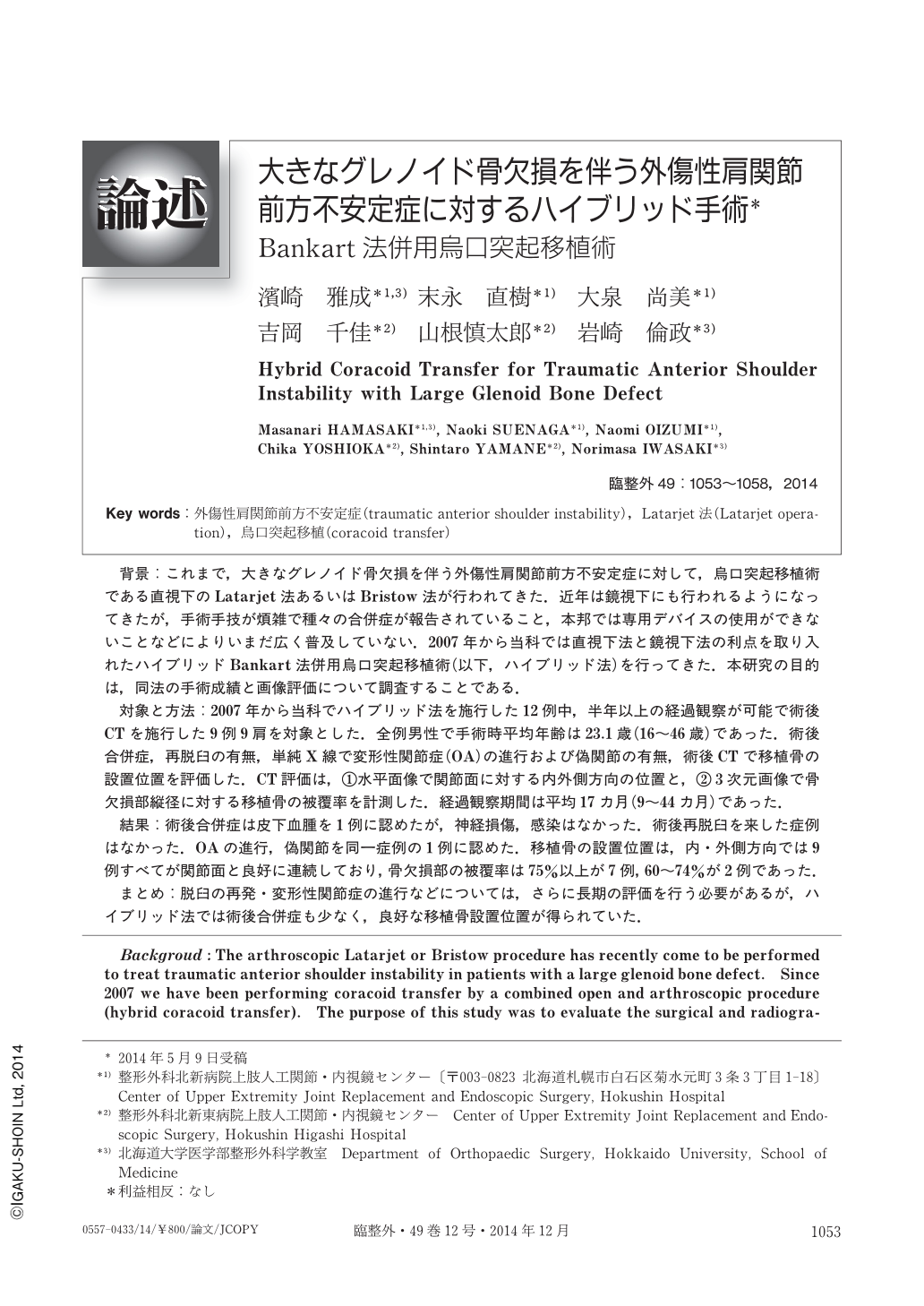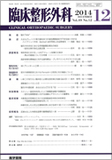Japanese
English
- 有料閲覧
- Abstract 文献概要
- 1ページ目 Look Inside
- 参考文献 Reference
背景:これまで,大きなグレノイド骨欠損を伴う外傷性肩関節前方不安定症に対して,烏口突起移植術である直視下のLatarjet法あるいはBristow法が行われてきた.近年は鏡視下にも行われるようになってきたが,手術手技が煩雑で種々の合併症が報告されていること,本邦では専用デバイスの使用ができないことなどによりいまだ広く普及していない.2007年から当科では直視下法と鏡視下法の利点を取り入れたハイブリッドBankart法併用烏口突起移植術(以下,ハイブリッド法)を行ってきた.本研究の目的は,同法の手術成績と画像評価について調査することである.
対象と方法:2007年から当科でハイブリッド法を施行した12例中,半年以上の経過観察が可能で術後CTを施行した9例9肩を対象とした.全例男性で手術時平均年齢は23.1歳(16〜46歳)であった.術後合併症,再脱臼の有無,単純X線で変形性関節症(OA)の進行および偽関節の有無,術後CTで移植骨の設置位置を評価した.CT評価は,①水平面像で関節面に対する内外側方向の位置と,②3次元画像で骨欠損部縦径に対する移植骨の被覆率を計測した.経過観察期間は平均17カ月(9〜44カ月)であった.
結果:術後合併症は皮下血腫を1例に認めたが,神経損傷,感染はなかった.術後再脱臼を来した症例はなかった.OAの進行,偽関節を同一症例の1例に認めた.移植骨の設置位置は,内・外側方向では9例すべてが関節面と良好に連続しており,骨欠損部の被覆率は75%以上が7例,60〜74%が2例であった.
まとめ:脱臼の再発・変形性関節症の進行などについては,さらに長期の評価を行う必要があるが,ハイブリッド法では術後合併症も少なく,良好な移植骨設置位置が得られていた.
Backgroud:The arthroscopic Latarjet or Bristow procedure has recently come to be performed to treat traumatic anterior shoulder instability in patients with a large glenoid bone defect. Since 2007 we have been performing coracoid transfer by a combined open and arthroscopic procedure (hybrid coracoid transfer). The purpose of this study was to evaluate the surgical and radiographic outcome of patients who underwent this procedure.
Methods:We evaluated the outcome in nine shoulders treated by arthroscopic coracoid transfer for traumatic anterior shoulder instability with greater than 25% glenoid bone loss. All of the patients were male, and their average age at surgery was 23.1 years old (range:16−46). We assessed complications, recurrence of instability, progression of osteoarthritis and pseudoarthritis on X-ray films, the position of the graft on CT scans, and the ① medial-lateral position of the graft in relation to the joint surface and ② coverage of the glenoid defect were also evaluated. The average follow-up period was 17 months (range:9−44).
Results:The only postoperative complication was a hematoma that occurred in 1 shoulder. There were no surgical wound infections, nerve injuries, or recurrences of instability. Progression of osteoarthritis and pseudoarthrosis was noted in 1 shoulder. The graft was flush against the glenoid surface in all shoulders. The coverage rate was greater than 75% in 7 shoulders and 60−74% in 2 shoulders.
Conclusions:Although longer follow-up for redislocation and osteoarthritis progression will be necessary, satisfactory placement of the graft was achieved by the hybrid coracoid transfer.

Copyright © 2014, Igaku-Shoin Ltd. All rights reserved.


